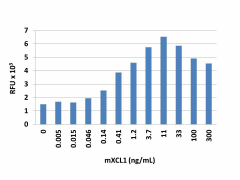- Regulatory Status
- RUO
- Other Names
- XCL1, Lymphotactin, Ltn, ATAC, SCYC1, SCM-1, SCM-1a, lymphotaxin, C motif chemokine 1, Small-inducible cytokine C1

-
The ED50 for mouse XCL1 is 0.2 - 1.2 ng/mL, as measured by its ability to chemoattract Ba/F3 mouse pro B cells transfected with human XCR1. -

Stability Testing for Recombinant Mouse XCL1. Recombinant Mouse XCL1 was aliquoted in PBS, pH7.2 at 0.2 mg/mL. One aliquot was frozen and thawed four times (4x Freeze/Thaws) and compared to the control that was kept at 4°C (control). The samples were tested for their ability to chemoattract Ba/F3 mouse pro B cells transfected with human XCR1. The ED50 for this effect is 0.2 - 1.2 ng/mL.
| Cat # | Size | Price | Quantity Check Availability | ||
|---|---|---|---|---|---|
| 783502 | 10 µg | $147.00 | |||
| 783504 | 25 µg | $288.00 | |||
Select size of product is eligible for a 40% discount! Promotion valid until December 31, 2024. Exclusions apply. To view full promotion terms and conditions or to contact your local BioLegend representative to receive a quote, visit our webpage.
XCL1, also known as lymphotactin, is an inflammatory chemokine secreted by T cells and natural killer (NK) cells. Early reports described XCL1 as a mediator of T cell and NK cell migration, but recent studies suggest a highly specialized role for XCL1 and its receptor XCR1. The XCL1-XCR1 axis has been shown to play an important role in the dendritic cell mediated cytotoxic immune response and in the formation of self-tolerance mechanisms through the development of regulatory T cells within the thymus. XCL1 also acts as a conformation-dependent inhibitor of HIV-1. Unlike other chemokines, XCL1 conformation interchanges between conserved chemokine folds and an unrelated dimeric structure under physiological conditions. The XCL1 monomer binds XCR1 with a high affinity, whereas the dimer form binds glycosaminoglycans (GAGs) with a high affinity, but fails to activate XCR1.
Product Details
- Source
- Mouse XCL1, amino acid Val22-Gly114 (accession #AAA56752.1), was expressed in E. coli.
- Molecular Mass
- The 93 amino acid recombinant protein has a predicted molecular mass of approximately 10.1 kD. The DTT-reduced and non-reduced protein migrates at approximately 12 kD and 15 kD respectively by SDS-PAGE. The predicted N-terminal amino acid is Val.
- Purity
- >98%, as determined by Coomassie stained SDS-PAGE.
- Formulation
- 0.22 μm filtered protein solution is in PBS pH 7.2.
- Endotoxin Level
- Less than 0.10 EU per μg cytokine as determined by the LAL method.
- Concentration
- 10-25 µg sizes are bottled at 200 µg/mL.
- Storage & Handling
- Unopened vial can be stored between 2°C and 8°C for up to 2 weeks, at -20°C for up to six months, or at -70°C or colder until the expiration date. For maximum results, quick spin vial prior to opening. The protein can be aliquoted and stored at -20°C or colder. Stock solutions can also be prepared at 50 - 100 µg/mL in appropriate sterile buffer, carrier protein such as 0.2 - 1% BSA or HSA can be added when preparing the stock solution. Aliquots can be stored between 2°C and 8°C for up to one week and stored at -20°C or colder for up to 3 months. Avoid repeated freeze/thaw cycles.
- Activity
- The ED50 is 0.2 -1.2 ng/mL, as measured by its ability to chemoattract Ba/F3 mouse pro B cells transfected with human XCR1.
- Application
-
Bioassay
- Application Notes
-
BioLegend carrier-free recombinant proteins provided in liquid format are shipped on blue ice. Our comparison testing data indicates that when handled and stored as recommended, the liquid format has equal or better stability and shelf-life compared to commercially available lyophilized proteins after reconstitution. Our liquid proteins are verified in-house to maintain activity after shipping on blue ice and are backed by our 100% satisfaction guarantee. If you have any concerns, contact us at tech@biolegend.com.
- Product Citations
-
Antigen Details
- Distribution
-
Spleen, peripheral leukocytes, CD4+ and CD8+ T cells, and natural killer (NK) cells.
- Function
- T cell and NK cell recruitment.
- Interaction
- T cell, NK cell, and Dendritic cells.
- Ligand/Receptor
- XCR1
- Bioactivity
- Chemoattract Ba/F3 mouse pro B cells transfected with human XCR1.
- Biology Area
- Immunology
- Molecular Family
- Cytokines/Chemokines
- Gene ID
- 16963 View all products for this Gene ID
- UniProt
- View information about XCL1 on UniProt.org

